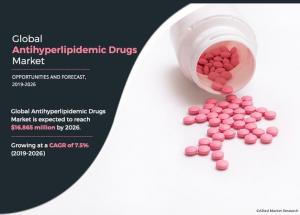Antihyperlipidemic Drugs Market: From $9.5 Billion in 2018 to a Projected $16.9 Billion by 2026
PORTLAND, OREGON, UNITED STATES, May 25, 2023 /EINPresswire.com/ -- The antihyperlipidemic drugs market experienced remarkable growth, with a valuation of $9,456 million in 2018. This upward trend is anticipated to continue, projecting a substantial surge to $16,865 million by 2026. An impressive compound annual growth rate (CAGR) of 7.5% is expected from 2019 to 2026, underlining the industry's potential for expansion and advancement in the coming years.
Antihyperlipidemic drugs are specifically designed to address hyperlipidemia. There are various types of these drugs available in the market, including bile acid sequestrants, cholesterol absorption inhibitors, and others. These medications work to reduce lipid levels and mitigate the risks associated with hyperlipidemia. By targeting different mechanisms within the body, these drugs help regulate lipid metabolism and promote healthier blood lipid profiles. Their usage plays a crucial role in managing hyperlipidemia and reducing the likelihood of cardiovascular events.
𝐑𝐞𝐪𝐮𝐞𝐬𝐭 𝐑𝐞𝐩𝐨𝐫𝐭 𝐒𝐚𝐦𝐩𝐥𝐞:https://www.alliedmarketresearch.com/request-sample/6284
Key Market Players
𝐀𝐁𝐁𝐕𝐈𝐄 𝐈𝐍𝐂., 𝐀𝐦𝐠𝐞𝐧 𝐈𝐧𝐜., 𝐀𝐬𝐭𝐫𝐚𝐙𝐞𝐧𝐞𝐜𝐚 𝐩𝐥𝐜, 𝐁𝐫𝐢𝐬𝐭𝐨𝐥-𝐌𝐲𝐞𝐫𝐬 𝐒𝐪𝐮𝐢𝐛𝐛 𝐂𝐨𝐦𝐩𝐚𝐧𝐲, 𝐃𝐚𝐢𝐢𝐜𝐡𝐢 𝐒𝐚𝐧𝐤𝐲𝐨 𝐂𝐨𝐦𝐩𝐚𝐧𝐲, 𝐋𝐢𝐦𝐢𝐭𝐞𝐝, 𝐃𝐫. 𝐑𝐞𝐝𝐝𝐲’𝐬 𝐋𝐚𝐛𝐨𝐫𝐚𝐭𝐨𝐫𝐢𝐞𝐬 𝐋𝐭𝐝, 𝐌𝐞𝐫𝐜𝐤 & 𝐂𝐨., 𝐈𝐧𝐜, 𝐌𝐲𝐥𝐚𝐧 𝐍.𝐕, 𝐏𝐟𝐢𝐳𝐞𝐫 𝐈𝐧𝐜., 𝐒𝐀𝐍𝐎𝐅𝐈 𝐒.𝐀.
𝐓𝐡𝐞 𝐚𝐧𝐭𝐢𝐡𝐲𝐩𝐞𝐫𝐥𝐢𝐩𝐢𝐝𝐞𝐦𝐢𝐜 𝐝𝐫𝐮𝐠𝐬 𝐦𝐚𝐫𝐤𝐞𝐭 𝐜𝐚𝐧 𝐛𝐞 𝐜𝐚𝐭𝐞𝐠𝐨𝐫𝐢𝐳𝐞𝐝 𝐛𝐚𝐬𝐞𝐝 𝐨𝐧 𝐝𝐫𝐮𝐠 𝐜𝐥𝐚𝐬𝐬 𝐚𝐧𝐝 𝐫𝐞𝐠𝐢𝐨𝐧. 𝐇𝐞𝐫𝐞 𝐢𝐬 𝐚 𝐛𝐫𝐞𝐚𝐤𝐝𝐨𝐰𝐧 𝐨𝐟 𝐭𝐡𝐞 𝐦𝐚𝐫𝐤𝐞𝐭 𝐢𝐧 𝐦𝐨𝐫𝐞 𝐝𝐞𝐭𝐚𝐢𝐥:
By Drug Class:
Statins: Statins are one of the most commonly prescribed antihyperlipidemic drugs. They work by inhibiting an enzyme involved in cholesterol synthesis, thereby reducing cholesterol levels in the blood.
Bile Acid Sequestrants: These drugs bind to bile acids in the intestine, preventing their reabsorption. This leads to increased excretion of cholesterol and helps lower lipid levels.
Cholesterol Absorption Inhibitors: These drugs block the absorption of dietary cholesterol in the intestines, reducing the amount of cholesterol that enters the bloodstream.
Fibric Acid Derivatives: Fibric acid derivatives primarily target triglyceride levels. They work by activating a specific receptor in the liver, leading to increased breakdown of triglycerides and decreased production of triglyceride-rich particles.
PCSK9 Inhibitors: PCSK9 inhibitors are a newer class of drugs that work by inhibiting the PCSK9 protein, which plays a role in regulating LDL receptor levels. By inhibiting PCSK9, these drugs increase the number of LDL receptors available to remove LDL cholesterol from the bloodstream.
Combination: Combination therapies involve the use of multiple antihyperlipidemic drugs together to achieve better lipid control. This approach may involve combining different drug classes or using fixed-dose combination medications.
Others: This category includes additional antihyperlipidemic drugs that may not fit into the aforementioned classes or represent emerging therapies in the market.
2. 𝐁𝐲 𝐑𝐞𝐠𝐢𝐨𝐧:
• North America: This region comprises the United States, Canada, and Mexico. It is a significant market for antihyperlipidemic drugs, with a strong focus on research and development in the pharmaceutical industry.
• Europe: The European market includes countries such as Germany, France, the United Kingdom, Italy, and the rest of Europe. Europe has a well-established healthcare infrastructure and a large patient population, driving the demand for antihyperlipidemic drugs.
• Asia-Pacific: This region encompasses Japan, China, India, and the rest of Asia-Pacific. The Asia-Pacific market is experiencing rapid growth due to factors such as increasing awareness of cardiovascular diseases and a rising geriatric population.
• LAMEA: LAMEA stands for Latin America, Middle East, and Africa. It includes countries like Brazil, South Africa, Saudi Arabia, and the rest of LAMEA. This region is witnessing a growing prevalence of hyperlipidemia and an increasing focus on healthcare infrastructure development.
𝐅𝐑𝐄𝐐𝐔𝐄𝐍𝐓𝐋𝐘 𝐀𝐒𝐊𝐄𝐃 𝐐𝐔𝐄𝐒𝐓𝐈𝐎𝐍𝐒?
1. What are the key factors driving the growth of the antihyperlipidemic drugs market?
2. Which drug class within the antihyperlipidemic drugs market is expected to witness the highest growth rate?
3. What are the major challenges faced by the antihyperlipidemic drugs market?
4. How does the market for antihyperlipidemic drugs differ between developed and developing regions?
5. What are the emerging trends in the antihyperlipidemic drugs market?
6. What are the regulatory considerations and approvals required for launching antihyperlipidemic drugs in different regions?
7. How is the market for antihyperlipidemic drugs influenced by the increasing prevalence of lifestyle-related diseases?
8. What are the potential side effects and safety concerns associated with antihyperlipidemic drugs?
9. Are there any significant advancements in drug delivery systems for antihyperlipidemic drugs?
10. What are the opportunities for market growth in the antihyperlipidemic drugs segment in terms of personalized medicine and targeted therapies?
𝐏𝐫𝐨𝐜𝐮𝐫𝐞 𝐂𝐨𝐦𝐩𝐥𝐞𝐭𝐞 𝐑𝐞𝐩𝐨𝐫𝐭 (184 𝐏𝐚𝐠𝐞𝐬 𝐏𝐃𝐅 𝐰𝐢𝐭𝐡 𝐈𝐧𝐬𝐢𝐠𝐡𝐭𝐬, 𝐂𝐡𝐚𝐫𝐭𝐬, 𝐓𝐚𝐛𝐥𝐞𝐬, 𝐚𝐧𝐝 𝐅𝐢𝐠𝐮𝐫𝐞𝐬)https://www.alliedmarketresearch.com/antihyperlipidemic-drugs-market/purchase-options
David Correa
Allied Analytics LLP
+ 1-800-792-5285
email us here
Legal Disclaimer:
EIN Presswire provides this news content "as is" without warranty of any kind. We do not accept any responsibility or liability for the accuracy, content, images, videos, licenses, completeness, legality, or reliability of the information contained in this article. If you have any complaints or copyright issues related to this article, kindly contact the author above.

